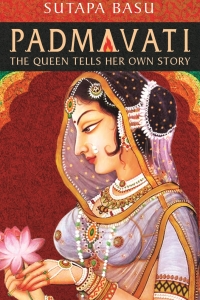
Journalist Mrinalini Rao is on an investigative trail to discover whether Padmavati, the Queen of Chittor, actually existed or was she only a legend created by poets.
Who was Padmavati, the Queen of Chittor? What does history tell of her? Where did she come from? What kind of life did she lead? How did she have the courage to jump willingly into fire?
Mrinalini goes to Chittorgarh to discover the truth. What does she really discover?
Prologue
The New Queen had decided.
It had been raining steadily for two days. Stormy winds had twisted trees and felled massive branches. Filled with sloshing, muddy water, the deep trapezium-like shaft, spread over a thousand square yards and referred to as the Kund or sacrificial fire cavity, could not be used for the pyre. Yet, any further delay would be disastrous. The sand in the hourglass trickled down steadily and the enemy was hammering at the gates.
The subterranean cavern would have to do, she had said. Bullock carts loaded with bundles of hay, wood-chips and numerous pots of clarified butter began drawing up to the mouth of the dark underground tunnel. Men, whose tears mingled with the rain, carried grist and fuel for the conflagration into the centre of the wide cave.
The queens, along with their ladies, maids and young girls, bathed and attired themselves from head to toe in gorgeous garments, jewels and ornaments. Married women bedecked themselves in their crimson-and-gold wedding finery. Some women held baby girls in their arms who smiled beatifically, unaware of their fate. After offering veneration to the deity and consuming a sacred meal that included a drink of whey and basil mildly laced with marijuana, the women began to approach the cavern. Men lined the path, hands folded, heads bowed in salutation to the satis. Husbands and brothers, fathers and sons, unmindful of the rain, were each searchingfor a beloved face.
In the enclosed space, the air was becoming scarce as the women surrounded a rude platform erected amidst mountains of hay and wood, liberally doused in clarified butter. The temple priests, having completed the rituals, stood by, chanting verses from the Vedas. Everyone waited for the senior queen to lead, but she seemed to falter. The New Queen gently slipped past her and ascended the platform. She sat down in the centre and folded her palms. Instead of closing her eyes, she looked ahead calmly. The other royal ladies clambered up to sit in a semicircle around her. Some had to be helped up by their maids because they were infirm or they were trembling with terror. The girls, maids, noblewomen and their female attendants stood behind the seated ladies, facing the priests. The babies in their arms looked around curiously, as if this was a new game. The chief priest held up a flaming torch. Calling out, ‘Jai! Ek Linghji Ki Jai,’ he lit the pyre.
Whoosh!! The hay, wood and butter sprang into a wavering pillar of fire. The priests ran pell-mell to the cave opening to escape the brute firestorm. The flames spread quickly, encircling the platform, sucking out whatever little air there was in the cave. The women clutched at their throats, desperate mouths agape. Shrill screams echoing down the tunnel were abruptly choked off. Some mothers smothered their children to save them from the agony of burning. A few girl infants escaped the laps of mothers who were already alight. Tiny limbs spewing flames, they ran around, shrieking at their unexpected torment.
Other women clutching babies, young girls and maidens attempted to jump off the burning platform. Though they had voluntarily embraced the idea of grace through fire, their instinct for survival rejected the terrible death facing them. But their leaps for freedom landed them right into fiery, blazing, scarlet hands that enveloped them lovingly. Burning bodies rolled on the rocky floor, already dead. Orange and blue tongues licked greedily at human skin, making the royal ladies screech uncontrollably. Some jumped up, beating their burning garments with bare hands in vain. Flames whirled around them until each became a separate bonfire reaching out to ignite more panicked women. All of it turned into an inferno of figures gyrating in agony. The roar of combustion growled within the cave, punctured by the hiss of sizzling skin and the sharp cracking of bones. A nauseating smell of burnt hair rose with clouds of thick grey smoke.
Once the pyre was burning merrily, the conflagration began to seek more air. Bellowing like an animal, the fire squeezed left and right through the narrow tunnel towards openings on both sides. The weeping men, still gathered just outside, were swept back as flames burst out of the tunnel.
In the centre of all the chaos, only one figure remained serene and motionless. As the gold, saffron and blue blaze made rings around her, rising higher and higher, slowly enclosing the New Queen, she was like a sculpture, absolutely still. Nothing seemed to touch her; not the torment, not the grief, not the fear. It defied all principles of logic. Where did a girl find such strength, not garnered even by the meditation of ascetics, to tolerate the torture of being burnt alive? Her dark silhouette, in lotus pose, palms folded, was a sublime sight. When the great white heat reached the core, her body exploded in a shower of sparks. The tremendous blast ricocheted against the red, hot rocky walls sending horrific echoes floating out to the listeners.
The jauhar took hardly a few minutes to extinguish Padmavati’s living mortality but gifted her with indelible immortality; a significant niche in the history of India. Time could not dim her charisma nor age wither her stunning beauty. For centuries to come, the supreme sacrifice of this legendary Queen of Chittor would attain a place of undying pride and honour in the hearts of all her country’s people.
About the Author







Comments